engine coolant SKODA YETI 2011 1.G / 5L User Guide
[x] Cancel search | Manufacturer: SKODA, Model Year: 2011, Model line: YETI, Model: SKODA YETI 2011 1.G / 5LPages: 252, PDF Size: 3.61 MB
Page 181 of 252
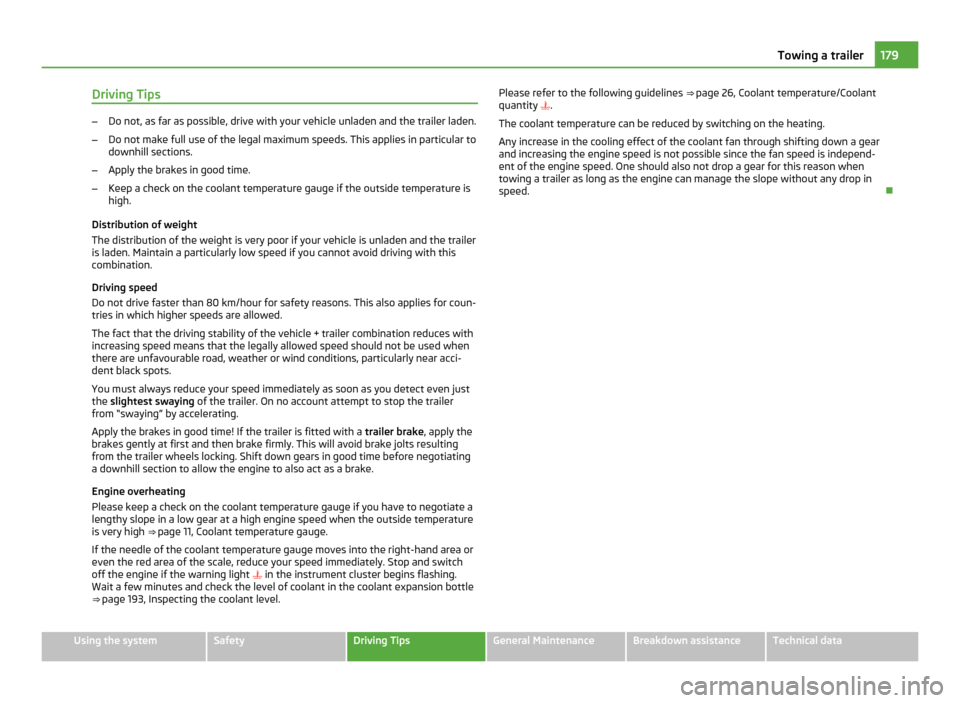
Driving Tips
–
Do not, as far as possible, drive with your vehicle unladen and the trailer laden.
– Do not make full use of the legal maximum speeds. This applies in particular to
downhill sections.
– Apply the brakes in good time.
– Keep a check on the coolant temperature gauge if the outside temperature is
high.
Distribution of weight
The distribution of the weight is very poor if your vehicle is unladen and the trailer
is laden. Maintain a particularly low speed if you cannot avoid driving with this
combination.
Driving speed
Do not drive faster than 80 km/hour for safety reasons. This also applies for coun-
tries in which higher speeds are allowed.
The fact that the driving stability of the vehicle + trailer combination reduces with
increasing speed means that the legally allowed speed should not be used when
there are unfavourable road, weather or wind conditions, particularly near acci-
dent black spots.
You must always reduce your speed immediately as soon as you detect even just
the slightest swaying of the trailer. On no account attempt to stop the trailer
from “swaying” by accelerating.
Apply the brakes in good time! If the trailer is fitted with a trailer brake, apply the
brakes gently at first and then brake firmly. This will avoid brake jolts resulting
from the trailer wheels locking. Shift down gears in good time before negotiating
a downhill section to allow the engine to also act as a brake.
Engine overheating
Please keep a check on the coolant temperature gauge if you have to negotiate a
lengthy slope in a low gear at a high engine speed when the outside temperature
is very high ⇒ page 11, Coolant temperature gauge
.
If the needle of the coolant temperature gauge moves into the right-hand area or
even the red area of the scale, reduce your speed immediately. Stop and switch
off the engine if the warning light in the instrument cluster begins flashing.
Wait a few minutes and check the level of coolant in the coolant expansion bottle
⇒ page 193, Inspecting the coolant level. Please refer to the following guidelines
⇒
page 26, Coolant temperature/Coolant
quantity .
The coolant temperature can be reduced by switching on the heating.
Any increase in the cooling effect of the coolant fan through shifting down a gear
and increasing the engine speed is not possible since the fan speed is independ-
ent of the engine speed. One should also not drop a gear for this reason when
towing a trailer as long as the engine can manage the slope without any drop in
speed. 179
Towing a trailer Using the system Safety Driving Tips General Maintenance Breakdown assistance Technical data
Page 191 of 252
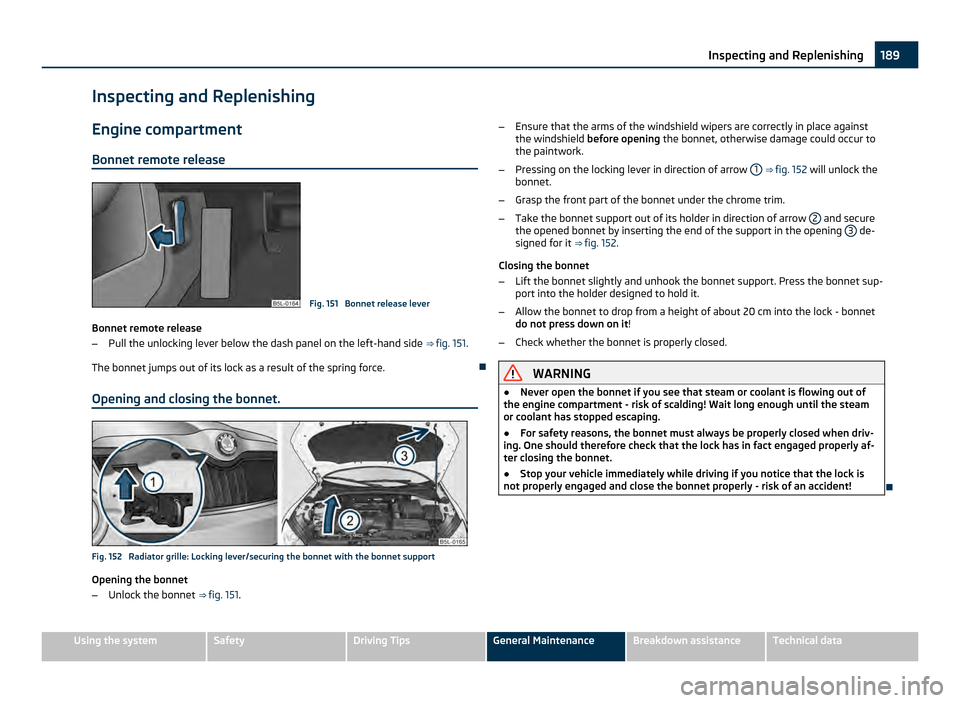
Inspecting and Replenishing
Engine compartment
Bonnet remote release Fig. 151 Bonnet release lever
Bonnet remote release
– Pull the unlocking lever below the dash panel on the left-hand side ⇒ fig. 151.
The bonnet jumps out of its lock as a result of the spring force.
Opening and closing the bonnet. Fig. 152 Radiator grille: Locking lever/securing the bonnet with the bonnet support
Opening the bonnet
–
Unlock the bonnet ⇒
fig. 151. –
Ensure that the arms of the windshield wipers are correctly in place against
the windshield before opening the bonnet, otherwise damage could occur to
the paintwork.
– Pressing on the locking lever in direction of arrow 1 ⇒
fig. 152 will unlock the
bonnet.
– Grasp the front part of the bonnet under the chrome trim.
– Take the bonnet support out of its holder in direction of arrow 2 and secure
the opened bonnet by inserting the end of the support in the opening 3 de-
signed for it ⇒ fig. 152.
Closing the bonnet
– Lift the bonnet slightly and unhook the bonnet support. Press the bonnet sup-
port into the holder designed to hold it.
– Allow the bonnet to drop from a height of about 20 cm into the lock - bonnet
do not press down on it!
– Check whether the bonnet is properly closed. WARNING
● Never open the bonnet if you see that steam or coolant is flowing out of
the engine compartment - risk of scalding! Wait long enough until the steam
or coolant has stopped escaping.
● For safety reasons, the bonnet must always be properly closed when driv-
ing. One should therefore check that the lock has in fact engaged properly af-
ter closing the bonnet.
● Stop your vehicle immediately while driving if you notice that the lock is
not properly engaged and close the bonnet properly - risk of an accident! 189
Inspecting and Replenishing Using the system Safety Driving Tips General Maintenance Breakdown assistance Technical data
Page 192 of 252
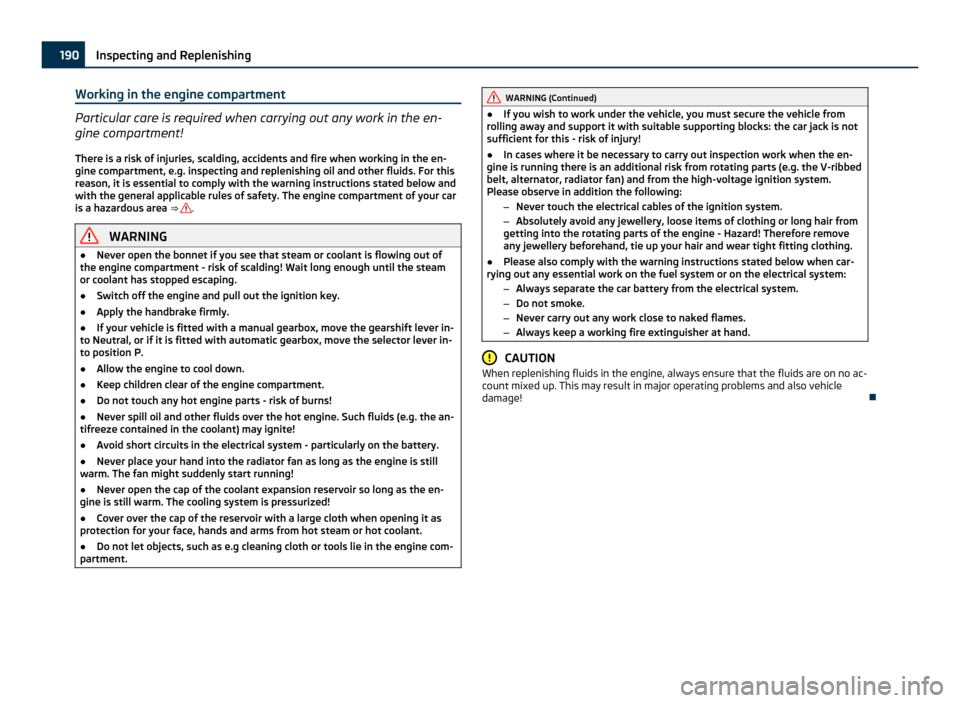
Working in the engine compartment
Particular care is required when carrying out any work in the en-
gine compartment!
There is a risk of injuries, scalding, accidents and fire when working in the en-
gine compartment, e.g. inspecting and replenishing oil and other fluids. For this
reason, it is essential to comply with the warning instructions stated below and
with the general applicable rules of safety. The engine compartment of your car
is a hazardous area ⇒
.
WARNING
● Never open the bonnet if you see that steam or coolant is flowing out of
the engine compartment - risk of scalding! Wait long enough until the steam
or coolant has stopped escaping.
● Switch off the engine and pull out the ignition key.
● Apply the handbrake firmly.
● If your vehicle is fitted with a manual gearbox, move the gearshift lever in-
to Neutral, or if it is fitted with automatic gearbox, move the selector lever in-
to position
P.
● Allow the engine to cool down.
● Keep children clear of the engine compartment.
● Do not touch any hot engine parts - risk of burns!
● Never spill oil and other fluids over the hot engine. Such fluids (e.g. the an-
tifreeze contained in the coolant) may ignite!
● Avoid short circuits in the electrical system - particularly on the battery.
● Never place your hand into the radiator fan as long as the engine is still
warm. The fan might suddenly start running!
● Never open the cap of the coolant expansion reservoir so long as the en-
gine is still warm. The cooling system is pressurized!
● Cover over the cap of the reservoir with a large cloth when opening it as
protection for your face, hands and arms from hot steam or hot coolant.
● Do not let objects, such as e.g cleaning cloth or tools lie in the engine com-
partment. WARNING (Continued)
● If you wish to work under the vehicle, you must secure the vehicle from
rolling away and support it with suitable supporting blocks: the car jack is not
sufficient for this - risk of injury!
● In cases where it be necessary to carry out inspection work when the en-
gine is running there is an additional risk from rotating parts (e.g. the V-ribbed
belt, alternator, radiator fan) and from the high-voltage ignition system.
Please observe in addition the following:
–Never touch the electrical cables of the ignition system.
– Absolutely avoid any jewellery, loose items of clothing or long hair from
getting into the rotating parts of the engine - Hazard! Therefore remove
any jewellery beforehand, tie up your hair and wear tight fitting clothing.
● Please also comply with the warning instructions stated below when car-
rying out any essential work on the fuel system or on the electrical system:
–Always separate the car battery from the electrical system.
– Do not smoke.
– Never carry out any work close to naked flames.
– Always keep a working fire extinguisher at hand. CAUTION
When replenishing fluids in the engine, always ensure that the fluids are on no ac-
count mixed up. This may result in major operating problems and also vehicle
damage! 190
Inspecting and Replenishing
Page 193 of 252
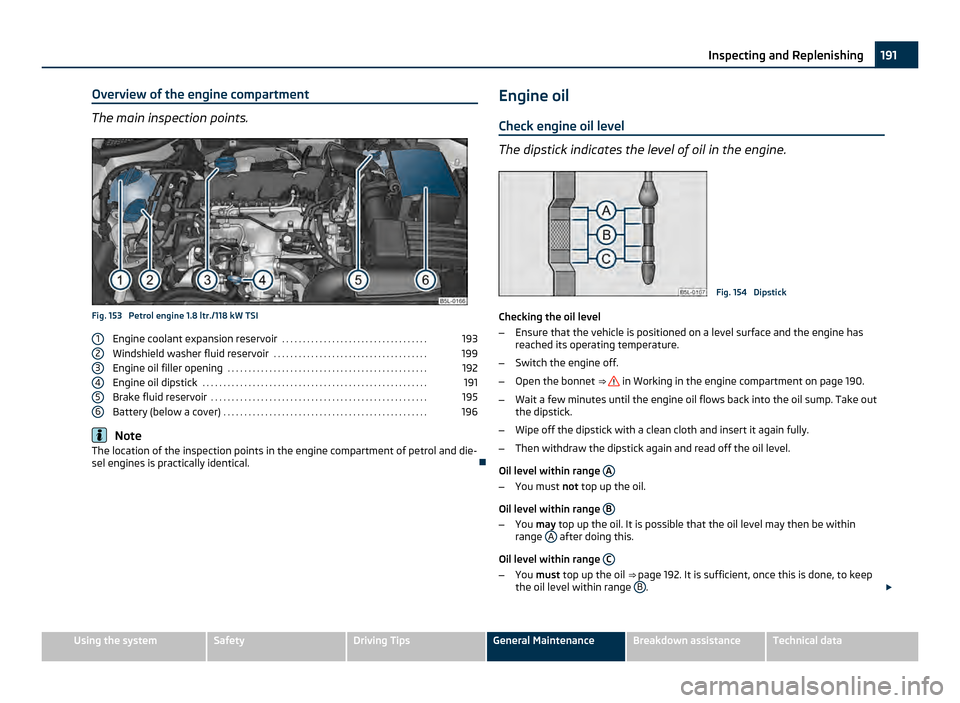
Overview of the engine compartment
The main inspection points.
Fig. 153 Petrol engine 1.8 ltr./118 kW TSI
Engine coolant expansion reservoir . . . . . . . . . . . . . . . . . . . . . . . . . . . . . . . . . . . 193
Windshield washer fluid reservoir . . . . . . . . . . . . . . . . . . . . . . . . . . . . . . . . . . . . . 199
Engine oil filler opening . . . . . . . . . . . . . . . . . . . . . . . . . . . . . . . . . . . . . . . . . . . . . . . . 192
Engine oil dipstick . . . . . . . . . . . . . . . . . . . . . . . . . . . . . . . . . . . . . . . . . . . . . . . . . . . . . . 191
Brake fluid reservoir . . . . . . . . . . . . . . . . . . . . . . . . . . . . . . . . . . . . . . . . . . . . . . . . . . . . 195
Battery (below a cover) . . . . . . . . . . . . . . . . . . . . . . . . . . . . . . . . . . . . . . . . . . . . . . . . . 196Note
The location of the inspection points in the engine compartment of petrol and die-
sel engines is practically identical.
1 2
3
4
5
6 Engine oil
Check engine oil level The dipstick indicates the level of oil in the engine.
Fig. 154 Dipstick
Checking the oil level
– Ensure that the vehicle is positioned on a level surface and the engine has
reached its operating temperature.
– Switch the engine off.
– Open the bonnet ⇒ in Working in the engine compartment on page 190.
– Wait a few minutes until the engine oil flows back into the oil sump. Take out
the dipstick.
– Wipe off the dipstick with a clean cloth and insert it again fully.
– Then withdraw the dipstick again and read off the oil level.
Oil level within range A –
You must not top up the oil.
Oil level within range B –
You may top up the oil. It is possible that the oil level may then be within
range A after doing this.
Oil level within range C –
You must top up the oil ⇒ page 192. It is sufficient, once this is done, to keep
the oil level within range B .
£ 191
Inspecting and Replenishing Using the system Safety Driving Tips General Maintenance Breakdown assistance Technical data
Page 195 of 252
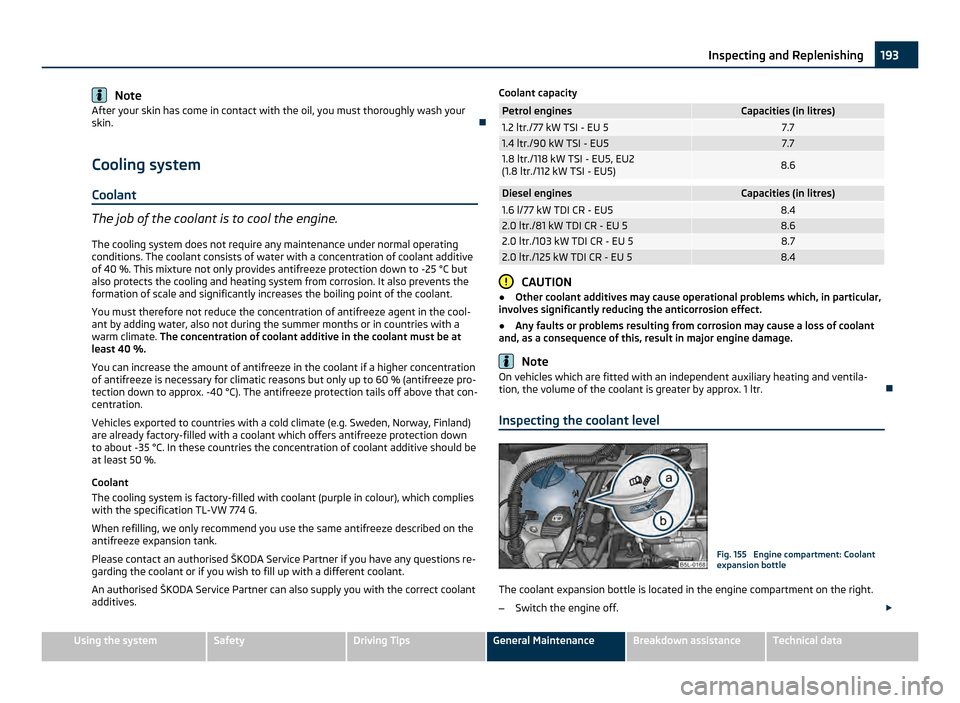
Note
After your skin has come in contact with the oil, you must thoroughly wash your
skin.
Cooling system
Coolant The job of the coolant is to cool the engine.
The cooling system does not require any maintenance under normal operating
conditions. The coolant consists of water with a concentration of coolant additive
of 40 %. This mixture not only provides antifreeze protection down to -25 °C but
also protects the cooling and heating system from corrosion. It also prevents the
formation of scale and significantly increases the boiling point of the coolant.
You must therefore not reduce the concentration of antifreeze agent in the cool-
ant by adding water, also not during the summer months or in countries with a
warm climate. The concentration of coolant additive in the coolant must be at
least 40 %.
You can increase the amount of antifreeze in the coolant if a higher concentration
of antifreeze is necessary for climatic reasons but only up to 60 % (antifreeze pro-
tection down to approx. -40 °C). The antifreeze protection tails off above that con-
centration.
Vehicles exported to countries with a cold climate (e.g. Sweden, Norway, Finland)
are already factory-filled with a coolant which offers antifreeze protection down
to about -35 °C. In these countries the concentration of coolant additive should be
at least 50 %.
Coolant
The cooling system is factory-filled with coolant (purple in colour), which complies
with the specification TL-VW
774 G.
When refilling, we only recommend you use the same antifreeze described on the
antifreeze expansion tank.
Please contact an authorised ŠKODA Service Partner if you have any questions re-
garding the coolant or if you wish to fill up with a different coolant.
An authorised ŠKODA Service Partner can also supply you with the correct coolant
additives. Coolant capacity Petrol engines Capacities (in litres)
1.2 ltr./77 kW TSI - EU 5 7.7
1.4 ltr./90 kW TSI - EU5 7.7
1.8 ltr./118 kW TSI - EU5, EU2
(1.8 ltr./112 kW TSI - EU5)
8.6
Diesel engines Capacities (in litres)
1.6 l/77 kW TDI CR - EU5 8.4
2.0 ltr./81 kW TDI CR - EU 5 8.6
2.0 ltr./103 kW TDI CR - EU 5 8.7
2.0 ltr./125 kW TDI CR - EU 5 8.4
CAUTION
● Other coolant additives may cause operational problems which, in particular,
involves significantly reducing the anticorrosion effect.
● Any faults or problems resulting from corrosion may cause a loss of coolant
and, as a consequence of this, result in major engine damage. Note
On vehicles which are fitted with an independent auxiliary heating and ventila-
tion, the volume of the coolant is greater by approx. 1 ltr.
Inspecting the coolant level Fig. 155 Engine compartment: Coolant
expansion bottle
The coolant expansion bottle is located in the engine compartment on the right.
– Switch the engine off. £ 193
Inspecting and Replenishing Using the system Safety Driving Tips General Maintenance Breakdown assistance Technical data
Page 196 of 252
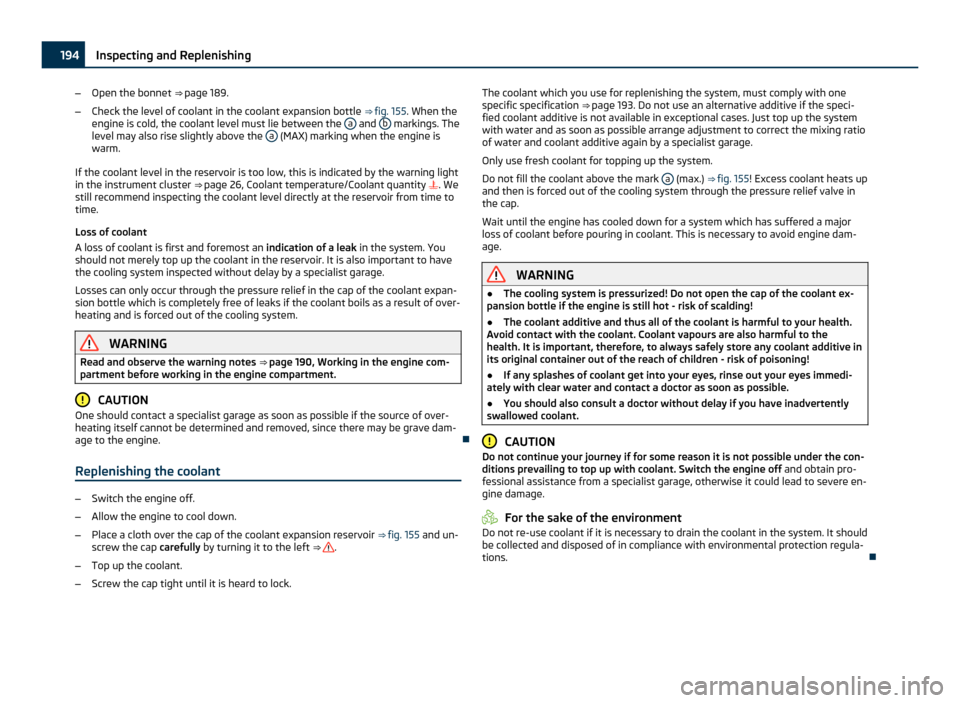
–
Open the bonnet ⇒ page 189 .
– Check the level of coolant in the coolant expansion bottle ⇒ fig. 155. When the
engine is cold, the coolant level must lie between the a and
b markings. The
level may also rise slightly above the a (MAX) marking when the engine is
warm.
If the coolant level in the reservoir is too low, this is indicated by the warning light
in the instrument cluster ⇒ page 26
, Coolant temperature/Coolant quantity . We
still recommend inspecting the coolant level directly at the reservoir from time to
time.
Loss of coolant
A loss of coolant is first and foremost an indication of a leak in the system. You
should not merely top up the coolant in the reservoir. It is also important to have
the cooling system inspected without delay by a specialist garage.
Losses can only occur through the pressure relief in the cap of the coolant expan-
sion bottle which is completely free of leaks if the coolant boils as a result of over-
heating and is forced out of the cooling system. WARNING
Read and observe the warning notes ⇒ page 190
, Working in the engine com-
partment before working in the engine compartment. CAUTION
One should contact a specialist garage as soon as possible if the source of over-
heating itself cannot be determined and removed, since there may be grave dam-
age to the engine.
Replenishing the coolant –
Switch the engine off.
– Allow the engine to cool down.
– Place a cloth over the cap of the coolant expansion reservoir ⇒
fig. 155 and un-
screw the cap carefully by turning it to the left ⇒ .
– Top up the coolant.
– Screw the cap tight until it is heard to lock. The coolant which you use for replenishing the system, must comply with one
specific specification ⇒ page 193. Do not use an alternative additive if the speci-
fied coolant additive is not available in exceptional cases. Just top up the system
with water and as soon as possible arrange adjustment to correct the mixing ratio
of water and coolant additive again by a specialist garage.
Only use fresh coolant for topping up the system.
Do not fill the coolant above the mark a (max.)
⇒ fig. 155 ! Excess coolant heats up
and then is forced out of the cooling system through the pressure relief valve in
the cap.
Wait until the engine has cooled down for a system which has suffered a major
loss of coolant before pouring in coolant. This is necessary to avoid engine dam-
age. WARNING
● The cooling system is pressurized! Do not open the cap of the coolant ex-
pansion bottle if the engine is still hot - risk of scalding!
● The coolant additive and thus all of the coolant is harmful to your health.
Avoid contact with the coolant. Coolant vapours are also harmful to the
health. It is important, therefore, to always safely store any coolant additive in
its original container out of the reach of children - risk of poisoning!
● If any splashes of coolant get into your eyes, rinse out your eyes immedi-
ately with clear water and contact a doctor as soon as possible.
● You should also consult a doctor without delay if you have inadvertently
swallowed coolant. CAUTION
Do not continue your journey if for some reason it is not possible under the con-
ditions prevailing to top up with coolant. Switch the engine off and obtain pro-
fessional assistance from a specialist garage, otherwise it could lead to severe en-
gine damage. For the sake of the environment
Do not re-use coolant if it is necessary to drain the coolant in the system. It should
be collected and disposed of in compliance with environmental protection regula-
tions. 194
Inspecting and Replenishing
Page 197 of 252
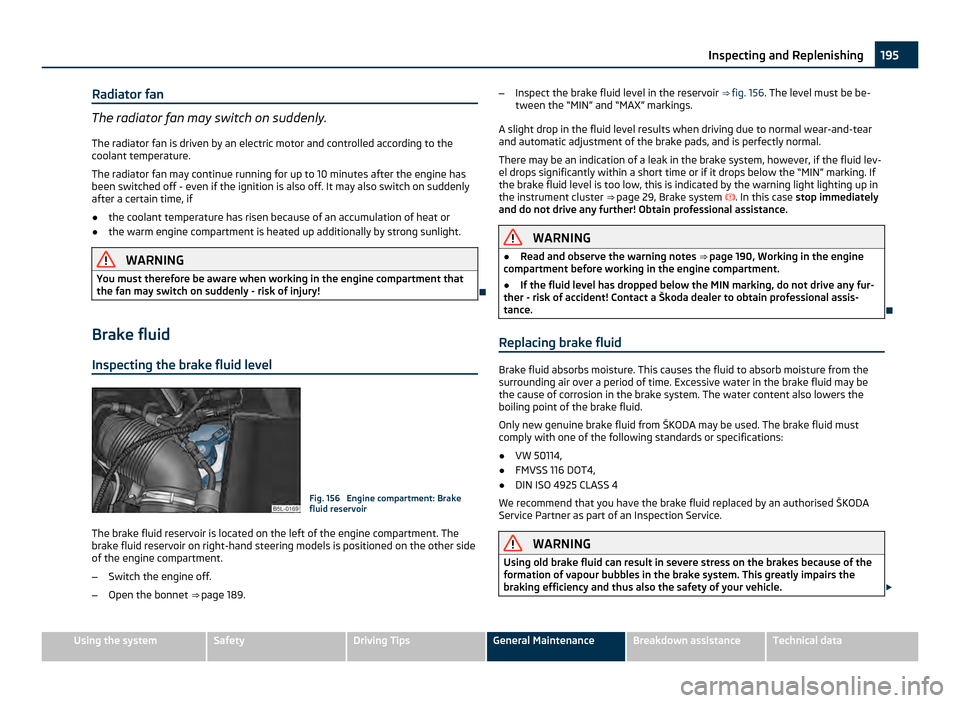
Radiator fan
The radiator fan may switch on suddenly.
The radiator fan is driven by an electric motor and controlled according to the
coolant temperature.
The radiator fan may continue running for up to 10 minutes after the engine has
been switched off - even if the ignition is also off. It may also switch on suddenly
after a certain time, if
● the coolant temperature has risen because of an accumulation of heat or
● the warm engine compartment is heated up additionally by strong sunlight. WARNING
You must therefore be aware when working in the engine compartment that
the fan may switch on suddenly - risk of injury!
Brake fluid
Inspecting the brake fluid level Fig. 156 Engine compartment: Brake
fluid reservoir
The brake fluid reservoir is located on the left of the engine compartment. The
brake fluid reservoir on right-hand steering models is positioned on the other side
of the engine compartment.
– Switch the engine off.
– Open the bonnet ⇒ page 189 . –
Inspect the brake fluid level in the reservoir ⇒
fig. 156. The level must be be-
tween the “MIN” and “MAX” markings.
A slight drop in the fluid level results when driving due to normal wear-and-tear
and automatic adjustment of the brake pads, and is perfectly normal.
There may be an indication of a leak in the brake system, however, if the fluid lev-
el drops significantly within a short time or if it drops below the “MIN” marking. If
the brake fluid level is too low, this is indicated by the warning light lighting up in
the instrument cluster ⇒ page 29, Brake system . In this case stop immediately
and do not drive any further! Obtain professional assistance. WARNING
● Read and observe the warning notes ⇒
page 190, Working in the engine
compartment before working in the engine compartment.
● If the fluid level has dropped below the MIN marking, do not drive any fur-
ther - risk of accident! Contact a Škoda dealer to obtain professional assis-
tance.
Replacing brake fluid Brake fluid absorbs moisture. This causes the fluid to absorb moisture from the
surrounding air over a period of time. Excessive water in the brake fluid may be
the cause of corrosion in the brake system. The water content also lowers the
boiling point of the brake fluid.
Only new genuine brake fluid from
ŠKODA may be used. The brake fluid must
comply with one of the following standards or specifications:
● VW 50114,
● FMVSS 116 DOT4,
● DIN ISO 4925 CLASS 4
We recommend that you have the brake fluid replaced by an authorised
ŠKODA
Service Partner as part of an Inspection Service. WARNING
Using old brake fluid can result in severe stress on the brakes because of the
formation of vapour bubbles in the brake system. This greatly impairs the
braking efficiency and thus also the safety of your vehicle. £ 195
Inspecting and Replenishing Using the system Safety Driving Tips General Maintenance Breakdown assistance Technical data
Page 223 of 252
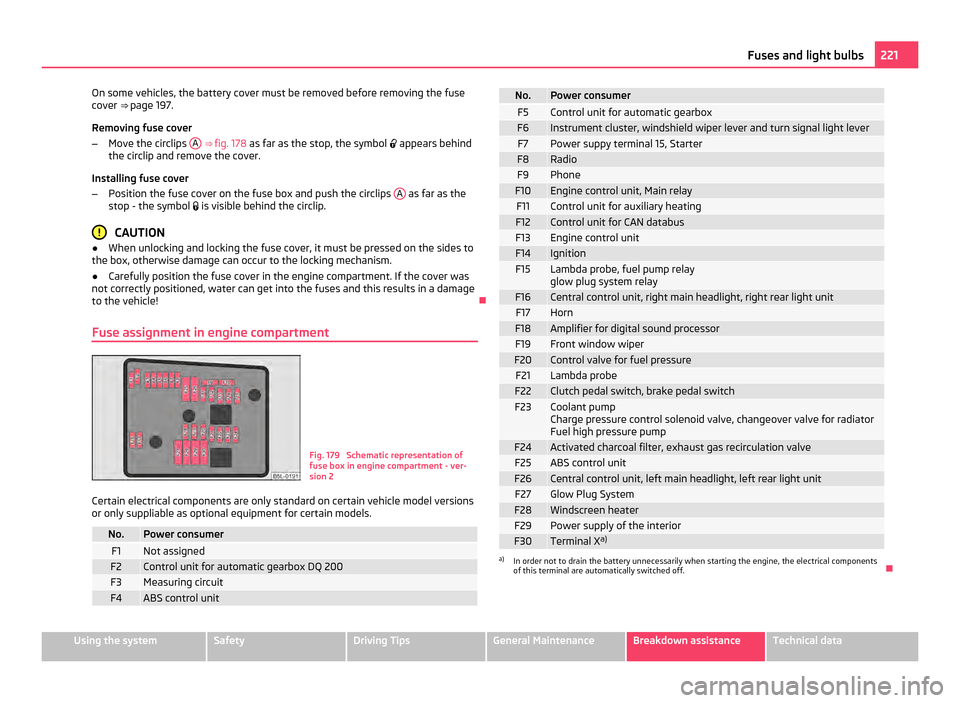
On some vehicles, the battery cover must be removed before removing the fuse
cover ⇒ page 197.
Removing fuse cover
–
Move the circlips A ⇒
fig. 178 as far as the stop, the symbol appears behind
the circlip and remove the cover.
Installing fuse cover
– Position the fuse cover on the fuse box and push the circlips A as far as the
stop - the symbol is visible behind the circlip.CAUTION
● When unlocking and locking the fuse cover, it must be pressed on the sides to
the box, otherwise damage can occur to the locking mechanism.
● Carefully position the fuse cover in the engine compartment. If the cover was
not correctly positioned, water can get into the fuses and this results in a damage
to the vehicle!
Fuse assignment in engine compartment Fig. 179 Schematic representation of
fuse box in engine compartment - ver-
sion 2
Certain electrical components are only standard on certain vehicle model versions
or only suppliable as optional equipment for certain models. No. Power consumer
F1 Not assigned
F2 Control unit for automatic gearbox DQ 200
F3 Measuring circuit
F4 ABS control unit No. Power consumer
F5 Control unit for automatic gearbox
F6 Instrument cluster, windshield wiper lever and turn signal light lever
F7 Power suppy terminal 15, Starter
F8 Radio
F9 Phone
F10 Engine control unit, Main relay
F11 Control unit for auxiliary heating
F12 Control unit for CAN databus
F13 Engine control unit
F14 Ignition
F15 Lambda probe, fuel pump relay
glow plug system relay
F16 Central control unit, right main headlight, right rear light unit
F17 Horn
F18 Amplifier for digital sound processor
F19 Front window wiper
F20 Control valve for fuel pressure
F21 Lambda probe
F22 Clutch pedal switch, brake pedal switch
F23 Coolant pump
Charge pressure control solenoid valve, changeover valve for radiator
Fuel high pressure pump
F24 Activated charcoal filter, exhaust gas recirculation valve
F25 ABS control unit
F26 Central control unit, left main headlight, left rear light unit
F27 Glow Plug System
F28 Windscreen heater
F29 Power supply of the interior
F30 Terminal X
a) a)
In order not to drain the battery unnecessarily when starting the engine, the electrical components
of this terminal are automatically switched off. 221
Fuses and light bulbs Using the system Safety Driving Tips General Maintenance Breakdown assistance Technical data
Page 243 of 252
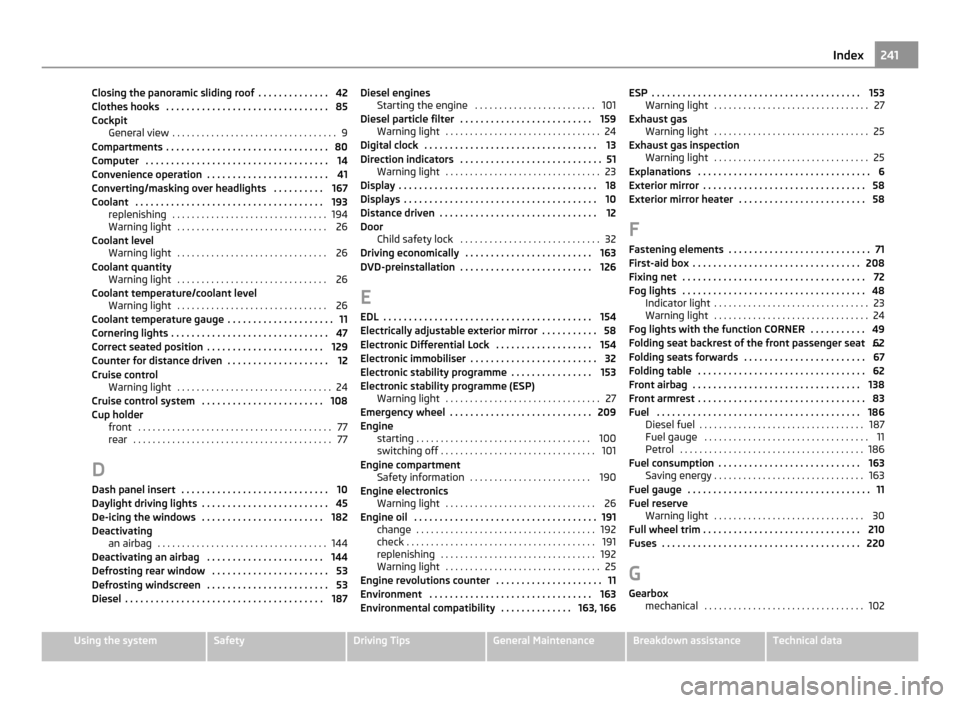
Closing the panoramic sliding roof . . . . . . . . . . . . . . 42
Clothes hooks . . . . . . . . . . . . . . . . . . . . . . . . . . . . . . . . 85
Cockpit General view . . . . . . . . . . . . . . . . . . . . . . . . . . . . . . . . . . 9
Compartments . . . . . . . . . . . . . . . . . . . . . . . . . . . . . . . . 80
Computer . . . . . . . . . . . . . . . . . . . . . . . . . . . . . . . . . . . . 14
Convenience operation . . . . . . . . . . . . . . . . . . . . . . . . 41
Converting/masking over headlights . . . . . . . . . . 167
Coolant . . . . . . . . . . . . . . . . . . . . . . . . . . . . . . . . . . . . . 193 replenishing . . . . . . . . . . . . . . . . . . . . . . . . . . . . . . . . 194
Warning light . . . . . . . . . . . . . . . . . . . . . . . . . . . . . . . 26
Coolant level Warning light . . . . . . . . . . . . . . . . . . . . . . . . . . . . . . . 26
Coolant quantity Warning light . . . . . . . . . . . . . . . . . . . . . . . . . . . . . . . 26
Coolant temperature/coolant level Warning light . . . . . . . . . . . . . . . . . . . . . . . . . . . . . . . 26
Coolant temperature gauge . . . . . . . . . . . . . . . . . . . . . 11
Cornering lights . . . . . . . . . . . . . . . . . . . . . . . . . . . . . . . 47
Correct seated position . . . . . . . . . . . . . . . . . . . . . . . 129
Counter for distance driven . . . . . . . . . . . . . . . . . . . . 12
Cruise control Warning light . . . . . . . . . . . . . . . . . . . . . . . . . . . . . . . . 24
Cruise control system . . . . . . . . . . . . . . . . . . . . . . . . 108
Cup holder front . . . . . . . . . . . . . . . . . . . . . . . . . . . . . . . . . . . . . . . . 77
rear . . . . . . . . . . . . . . . . . . . . . . . . . . . . . . . . . . . . . . . . . 77
D
Dash panel insert . . . . . . . . . . . . . . . . . . . . . . . . . . . . . 10
Daylight driving lights . . . . . . . . . . . . . . . . . . . . . . . . . 45
De-icing the windows . . . . . . . . . . . . . . . . . . . . . . . . 182
Deactivating an airbag . . . . . . . . . . . . . . . . . . . . . . . . . . . . . . . . . . . 144
Deactivating an airbag . . . . . . . . . . . . . . . . . . . . . . . 144
Defrosting rear window . . . . . . . . . . . . . . . . . . . . . . . 53
Defrosting windscreen . . . . . . . . . . . . . . . . . . . . . . . . 53
Diesel . . . . . . . . . . . . . . . . . . . . . . . . . . . . . . . . . . . . . . . 187 Diesel engines
Starting the engine . . . . . . . . . . . . . . . . . . . . . . . . . 101
Diesel particle filter . . . . . . . . . . . . . . . . . . . . . . . . . . 159 Warning light . . . . . . . . . . . . . . . . . . . . . . . . . . . . . . . . 24
Digital clock . . . . . . . . . . . . . . . . . . . . . . . . . . . . . . . . . . 13
Direction indicators . . . . . . . . . . . . . . . . . . . . . . . . . . . . 51 Warning light . . . . . . . . . . . . . . . . . . . . . . . . . . . . . . . . 23
Display . . . . . . . . . . . . . . . . . . . . . . . . . . . . . . . . . . . . . . . 18
Displays . . . . . . . . . . . . . . . . . . . . . . . . . . . . . . . . . . . . . . 10
Distance driven . . . . . . . . . . . . . . . . . . . . . . . . . . . . . . . 12
Door Child safety lock . . . . . . . . . . . . . . . . . . . . . . . . . . . . . 32
Driving economically . . . . . . . . . . . . . . . . . . . . . . . . . 163
DVD-preinstallation . . . . . . . . . . . . . . . . . . . . . . . . . . 126
EEDL . . . . . . . . . . . . . . . . . . . . . . . . . . . . . . . . . . . . . . . . . 154
Electrically adjustable exterior mirror . . . . . . . . . . . 58
Electronic Differential Lock . . . . . . . . . . . . . . . . . . . 154
Electronic immobiliser . . . . . . . . . . . . . . . . . . . . . . . . . 32
Electronic stability programme . . . . . . . . . . . . . . . . 153
Electronic stability programme (ESP) Warning light . . . . . . . . . . . . . . . . . . . . . . . . . . . . . . . . 27
Emergency wheel . . . . . . . . . . . . . . . . . . . . . . . . . . . . 209
Engine starting . . . . . . . . . . . . . . . . . . . . . . . . . . . . . . . . . . . . 100
switching off . . . . . . . . . . . . . . . . . . . . . . . . . . . . . . . . 101
Engine compartment Safety information . . . . . . . . . . . . . . . . . . . . . . . . . 190
Engine electronics Warning light . . . . . . . . . . . . . . . . . . . . . . . . . . . . . . . 26
Engine oil . . . . . . . . . . . . . . . . . . . . . . . . . . . . . . . . . . . . 191 change . . . . . . . . . . . . . . . . . . . . . . . . . . . . . . . . . . . . . 192
check . . . . . . . . . . . . . . . . . . . . . . . . . . . . . . . . . . . . . . . 191
replenishing . . . . . . . . . . . . . . . . . . . . . . . . . . . . . . . . 192
Warning light . . . . . . . . . . . . . . . . . . . . . . . . . . . . . . . . 25
Engine revolutions counter . . . . . . . . . . . . . . . . . . . . . 11
Environment . . . . . . . . . . . . . . . . . . . . . . . . . . . . . . . . 163
Environmental compatibility . . . . . . . . . . . . . . 163, 166 ESP . . . . . . . . . . . . . . . . . . . . . . . . . . . . . . . . . . . . . . . . . 153
Warning light . . . . . . . . . . . . . . . . . . . . . . . . . . . . . . . . 27
Exhaust gas Warning light . . . . . . . . . . . . . . . . . . . . . . . . . . . . . . . . 25
Exhaust gas inspection Warning light . . . . . . . . . . . . . . . . . . . . . . . . . . . . . . . . 25
Explanations . . . . . . . . . . . . . . . . . . . . . . . . . . . . . . . . . . 6
Exterior mirror . . . . . . . . . . . . . . . . . . . . . . . . . . . . . . . . 58
Exterior mirror heater . . . . . . . . . . . . . . . . . . . . . . . . . 58
F
Fastening elements . . . . . . . . . . . . . . . . . . . . . . . . . . . . 71
First-aid box . . . . . . . . . . . . . . . . . . . . . . . . . . . . . . . . . 208
Fixing net . . . . . . . . . . . . . . . . . . . . . . . . . . . . . . . . . . . . 72
Fog lights . . . . . . . . . . . . . . . . . . . . . . . . . . . . . . . . . . . . 48 Indicator light . . . . . . . . . . . . . . . . . . . . . . . . . . . . . . . . 23
Warning light . . . . . . . . . . . . . . . . . . . . . . . . . . . . . . . . 24
Fog lights with the function CORNER . . . . . . . . . . . 49
Folding seat backrest of the front passenger seat . .62
Folding seats forwards . . . . . . . . . . . . . . . . . . . . . . . . 67
Folding table . . . . . . . . . . . . . . . . . . . . . . . . . . . . . . . . . 62
Front airbag . . . . . . . . . . . . . . . . . . . . . . . . . . . . . . . . . 138
Front armrest . . . . . . . . . . . . . . . . . . . . . . . . . . . . . . . . . 83
Fuel . . . . . . . . . . . . . . . . . . . . . . . . . . . . . . . . . . . . . . . . 186 Diesel fuel . . . . . . . . . . . . . . . . . . . . . . . . . . . . . . . . . . 187
Fuel gauge . . . . . . . . . . . . . . . . . . . . . . . . . . . . . . . . . . 11
Petrol . . . . . . . . . . . . . . . . . . . . . . . . . . . . . . . . . . . . . . 186
Fuel consumption . . . . . . . . . . . . . . . . . . . . . . . . . . . . 163 Saving energy . . . . . . . . . . . . . . . . . . . . . . . . . . . . . . . 163
Fuel gauge . . . . . . . . . . . . . . . . . . . . . . . . . . . . . . . . . . . . 11
Fuel reserve Warning light . . . . . . . . . . . . . . . . . . . . . . . . . . . . . . . 30
Full wheel trim . . . . . . . . . . . . . . . . . . . . . . . . . . . . . . . 210
Fuses . . . . . . . . . . . . . . . . . . . . . . . . . . . . . . . . . . . . . . . 220
G
Gearbox mechanical . . . . . . . . . . . . . . . . . . . . . . . . . . . . . . . . . 102 241
Index Using the system Safety Driving Tips General Maintenance Breakdown assistance Technical data